Lessons from the San Francisco Bay Area Study Tour: Michael Huber
The ULI Rose Center for Public Leadership spoke with Greater Indianapolis Chamber of Commerce President and CEO Michael Huber, a 2013-2014 Daniel Rose Fellow, about the program’s December 2013 study visit to the San Francisco Bay Area.
Rose Center: On the San Francisco Study Tour, we explored a variety of land use and economic development challenges facing the Bay Area. Lessons learned will come into play as the Daniel Rose Fellows address comparable challenges in each of the four fellowship cities. What, for you, was the greatest takeaway of the Study Tour?
Michael Huber: It allowed us to delve pretty deeply into issues of regulation and land use in the Bay Area, and getting exposure to people in the local development community was very helpful as well. But just as importantly, spending time with the other Rose Fellows helps to set the stage for the rest of the fellowship year. It allows us to get to know one another and develop relationships, so that those relationships are in place as we conduct the subsequent visits to each fellowship city.
In Indianapolis, your team has challenged itself to attract investment to three vacant industrial sites. How does your situation compare with what you found in the Bay Area?
In San Francisco—with the density, the natural boundaries to urban growth, the concentration of talent that’s arrived from out of town — the economics are completely flipped around compared to what you find in a Rust Belt city like Indianapolis or a place like Memphis.
In a market like Indianapolis we’re looking for creative ways to subsidize development. In San Francisco they’re looking for ways to take booming, healthy, market rate development, and use a variety of tools—such as impact fees—to support and benefit other areas and other functions of the city.
It’s such a different way of thinking, but it’s so educational to find out how other markets work.
There were a lot of really helpful takeaways, such as how even relatively minor land use and planning regulations and actions can create big incentives—or disincentives—for developers.
What kinds of incentives did you see on the Study Tour?
In Oakland, the main takeaway was that being very strategic about retail is very important. Even though we don’t have anywhere near the density of Oakland, that’s something I think we can apply here in Indianapolis.
In the Broadway corridor and Uptown, I saw that they were very intentional about what kind of retail they attracted. In a lot of other cities, government does not get involved in programming for retail spaces. They say, “Let’s invest in this neighborhood, create a space for retail to operate,” but don’t go any further than that. In Oakland, it was different. They were very specific about certain buildings and who they were trying to recruit. It was an integral part of their development strategy.
I think these are strategies that we can adopt that would work well.
In addition to retail, we explored some of the issues facing the region’s manufacturing sector.
At SFMade, [Senior Director Janet Lees] gave us a lot of ideas on how we can unite local manufacturers, especially niche manufacturers, around a common identity and how they can support each other.
In San Francisco, SFMade’s goal is to try and preserve manufacturing jobs so they don’t get moved out of the city as the rents get higher. Our situation is a little different, though — we’ve got plenty of manufacturing jobs. And because our city is already so spread out, we’re probably less picky about where they’re located. For us, the goal is to create a stronger sense of identity for Indianapolis-made brands, to try to promote the growth of those companies.
In a discussion at SPUR, we delved into housing issues in San Francisco and the four fellowship cities. Describing the situation in Indianapolis, you said, “We’ve got plenty of affordable housing and too many abandoned homes.” How are you addressing residential vacancies in your city?
We have these formerly middle class neighborhoods that were powered by big automotive facilities. Surrounding our downtown are miles and miles of single family homes, probably 15,000 of them abandoned.
From a regulatory standpoint, we’re trying to cut out as many of the steps as possible, trying to streamline the process from the time a house becomes abandoned to the time it’s conveyed to local government. And we are doing this while still doing everything we can to protect individual property rights.
From an operating standpoint, we’ve created a new nonprofit land bank. We’ve started to make a dent in the problem but the improvements are nowhere near the scale we need.
Earlier you spoke of the importance of developing ongoing relationships with the other Daniel Rose Fellows. Have your relationships with the other Rose Fellows provided any inspiration on the housing front?
In my case, I was assigned to work with the Portland team. I’ve learned that if a city, or a chamber of commerce, really wants to address these urban neighborhoods and have a viable combination of manufacturing and single family homes, we need to change our entire approach. My work with the Portland fellows started a great conversation on this subject. It’s a direction we know we need to go.
In most cities, we have community folks, neighborhood associations and community development corporations. And we also have the corporate expansion people, the business attraction people. But what we don’t have is a good dedicated group of people to work on these urban infill issues: old manufacturing facilities, brownfields and so on.
[The other fellows] challenged us, providing recommendations on how to realign our resources around a new economic development strategy that more successfully addresses urban infill development. Specifically, we studied areas where there’s a combination of industrial uses and neighborhood housing.
Do you feel that you grew, on a professional level, from the Study Tour experience?
Absolutely. The Study Tour allowed all of us Rose Fellows to become more educated about what’s happening in other markets; more educated about how public and private entities can work together to solve problems in other cities. To be in that environment, amongst the leading practitioners — I don’t think there is any substitute for that.
Ultimately, we return home with very concrete ways in which we can improve our economic and community development work here in Indianapolis.
This interview was conducted by Timothy Boscarino of Issue Media Group.



